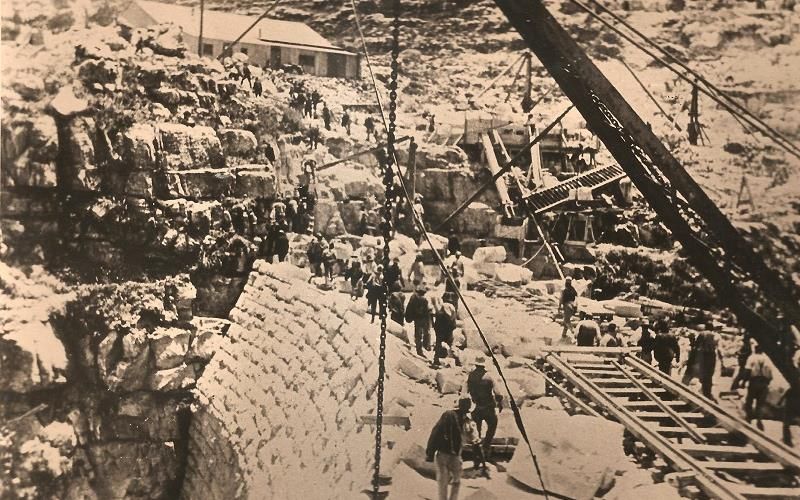Woodhead Dam has been providing water to the residents of Cape Town for 126 years, exemplifying the city’s perseverance in addressing water challenges. The dam’s construction in the 1890s was a groundbreaking project led by young Scottish engineer Tom Stewart, and was named in honor of then-Mayor Sir John Woodhead who placed the final brick. The dam has been recognized as an International Civil Engineering Landmark and serves as a symbol of the city’s commitment to building lasting infrastructure and creating a water-resilient future.
A Historical Gem: The Origins of Woodhead Dam
During Heritage Month, we pause to appreciate the 126-year legacy of Woodhead Dam in providing water to Cape Town’s residents. This magnificent structure exemplifies the city’s perseverance and commitment to addressing water challenges from the past to the present.
The tale of Woodhead Dam commences in the early 1890s when Cape Town confronted two significant issues – the necessity for a storage dam to guarantee water supply from the Disa River year-round, and the resolution to the water shortages experienced in the 1850s. Colonial hydraulic engineer John Gamble validated the dam’s viability by illustrating that the region’s rainfall made it a perfect location.
Despite initial reluctance from city authorities due to financial constraints, young Scottish engineer Tom Stewart was commissioned to design and construct the dam. Named in honor of then-Mayor Sir John Woodhead, who is believed to have placed the final brick during its construction, Woodhead became Cape Town’s first large stone masonry dam. Sir John Woodhead was knighted for leading this groundbreaking project.
Building Woodhead Dam: An Engineering Feat
Constructing the dam proved to be an immense undertaking due to the difficulties in transporting workers, equipment, and cement to the site. An ingenious solution, possibly involving the first cableway from Camps Bay to Kasteelpoort and rail tracks, was devised. A steam locomotive was used to transport workers and materials to the construction site on Table Mountain. Machinery, experienced stonemasons, and quarrymen were brought in from Scotland, while a steam crane was imported from Wales to power the cableway. The labor-intensive construction of the dam commenced in 1894 and concluded in 1898.
Over the years, more reservoirs were constructed nearby, such as the Hely-Hutchinson Dam and three smaller dams. Woodhead Dam, together with these adjacent structures, continues to serve Cape Town today, collectively supplying approximately 1% of the city’s water needs.
In 2007, the American Society of Civil Engineers (ASCE) designated Woodhead Dam as an International Civil Engineering Landmark, acknowledging its innovation and long-standing service in South Africa. This distinction emphasizes the dam’s relevance to the water challenges Cape Town has encountered recently, including the 2018 drought.
The City’s Commitment to a Water-Resilient Future
The Woodhead Dam’s lasting presence exemplifies the resilience of Cape Town and its citizens. The city’s dedication to constructing robust infrastructure is apparent in the building of its primary dams, which provide essential services to its inhabitants.
Aware of the challenges imposed by climate change, Cape Town is committed to creating a water-resilient future. The City Council recognizes that the city cannot rely exclusively on dams for water security, and as a result, is investing in its New Water Programme. According to Mayoral Committee Member for Water and Sanitation, Councillor Zahid Badroodien, this initiative aims to decrease Cape Town’s reliance on rainfall and dam storage as primary water sources by bringing an additional 300 million liters of water online from alternative sources by 2030.
As we commemorate the 126th anniversary of the Woodhead Dam, we are reminded of Cape Town’s water heritage and the city’s unwavering resilience in tackling water challenges. The dam serves as a symbol of dedication to building lasting infrastructure and adapting to the ever-changing needs of its residents. Reflecting on the dam’s storied past, we can anticipate a more sustainable and water-resilient future for Cape Town and its people.
1. What is Woodhead Dam?
Woodhead Dam is a large stone masonry dam in Cape Town that has been providing water to the city’s residents for 126 years.
2. Who designed and constructed Woodhead Dam?
The dam was designed and constructed by young Scottish engineer Tom Stewart.
3. Why was Woodhead Dam named after Sir John Woodhead?
Sir John Woodhead, then-Mayor of Cape Town, is believed to have placed the final brick during the construction of the dam, and was thus honored by having the dam named after him.
4. What is the significance of Woodhead Dam?
Woodhead Dam is recognized as an International Civil Engineering Landmark, and serves as a symbol of the city’s commitment to building lasting infrastructure and creating a water-resilient future.
5. How was Woodhead Dam constructed?
Constructing Woodhead Dam proved to be an immense undertaking due to the difficulties in transporting workers, equipment, and cement to the site. A steam locomotive, cableway, and machinery, experienced stonemasons, and quarrymen were used in the construction.
6. What other reservoirs were constructed nearby Woodhead Dam?
Hely-Hutchinson Dam and three smaller dams were constructed nearby Woodhead Dam.
7. What is the City of Cape Town doing to create a water-resilient future?
The City Council recognizes that the city cannot rely exclusively on dams for water security, and as a result, is investing in its New Water Programme. This initiative aims to decrease Cape Town’s reliance on rainfall and dam storage as primary water sources by bringing an additional 300 million liters of water online from alternative sources by 2030.
8. What is the importance of Woodhead Dam in relation to Cape Town’s water heritage?
Woodhead Dam serves as a reminder of Cape Town’s perseverance and commitment to addressing water challenges from the past to the present, and serves as a symbol of dedication to building lasting infrastructure and adapting to the ever-changing needs of its residents.








